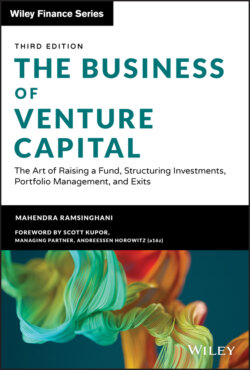Читать книгу The Business of Venture Capital - Mahendra Ramsinghani - Страница 36
GETTING LUCKY — WHEN OPPORTUNITY MEETS A PREPARED MIND
ОглавлениеFor a few chosen practitioners, the entry into venture capital was not an uphill crawl or a series of grueling interviews. It was a calling — a blaring siren. Bryce Roberts was planning to go to law school and in the interim decided to start a ski company in Jackson Hole, Wyoming. “One of my neighbors, a venture capitalist, invited me to sit in on pitch meetings and offer feedback,” he says. Bryce went on to be the co-founder of O'Reilly Alphatec Ventures, which has led investments in a number of prominent technology startups.
Jack Ahrens, co-founder of T-Gap Ventures, has been in the venture business for over 30 years. While he was employed at a bank in Illinois, one afternoon he stumbled upon an internal memo that suggested his department was being shut down. “I was irritated and told my boss I would be leaving.” His boss promptly jumped in: “We have a venture capital arm — what if we made you the president and gave you a raise?” “I took it — I barely knew what the heck venture capital was, but here I was a VC for three decades,” says Jack. In these three decades, Jack has led over 35 successful exits, including 20 IPOs. Interestingly, neither Bryce nor Jack has the desire to grow his fund size beyond what is manageable. My own observation is that if they wished, they could easily raise a lot more capital and increase their fund size, but so far they have curbed any such inflated ambitions. For those who followed their calling, the ability to find strong investment opportunities, generate returns, and stay on the growth trajectory is not difficult.
There is no way of knowing whether you are a natural, as Sanford Bernstein puts it. Bernstein, founder of the investment banking firm Robertson Stephens and Company, had invested in venture funds for 20 years. “Some do it, some can't, and like with athletes, there is no way of telling ’till they take the field,” he once remarked.23
To prove they are good athletes, venture capitalists need to pick good investment opportunities. John Doerr used to say that training a new venture capitalist was not unlike preparing a fighter pilot for battle. It takes six to eight years, and you should be prepared for losses of about $20 million.24 Yet in its first fund, Hummer-Winblad invested in 17 companies, of which 16 yielded a positive return. Jan Garfinkle's Arboretum Ventures Fund I had two exits in quick succession that yielded strong returns — comfortably landing the fund in the top quartile.
It does help to have a reasonable measure of luck on your side. When Jan Garfinkle decided to raise her first fund, Arboretum Ventures, she met a leading LP over Chinese food to discuss her game plan. The LP committed, and the fortune cookie, now pasted in Jan's journal, said, “You will soon get something you've always wanted.” Fifteen years later, Jan is raising her Fund V, which is 10 times the size of her Fund I. When she launched her Fund I, she expressed the desire to serve this industry and be on the board of the National Venture Capital Association.25 Ten years later, she served as the chair of this association.
David Cowan of Bessemer Venture Partners adds it all up nicely: “The one most important quality of a successful venture capitalist is luck.”26 Arthur Rock, who was an investor in Apple, Intel, and some of the formative companies of the technology era, says, “You gotta be lucky. Everybody's gonna be lucky at some time or another. I was lucky to be lucky early in my career.”27
In the business of venture capital, luck is necessary but not a sufficient condition.
